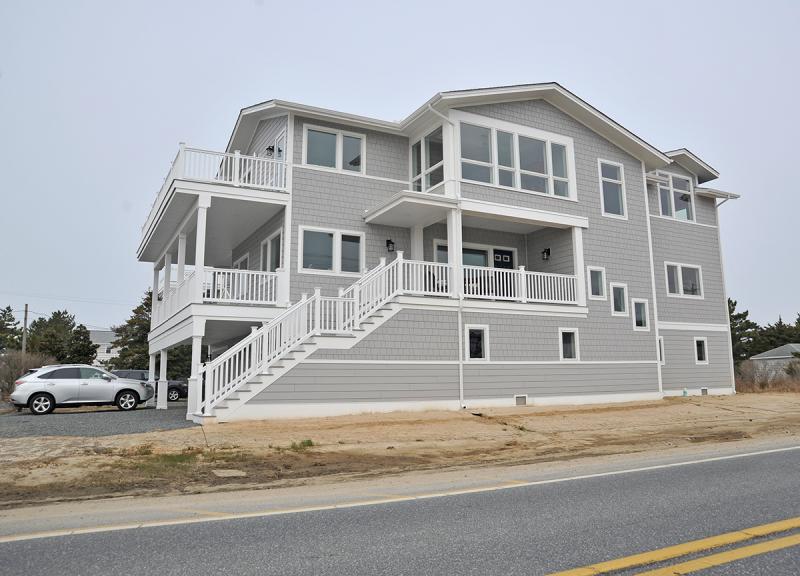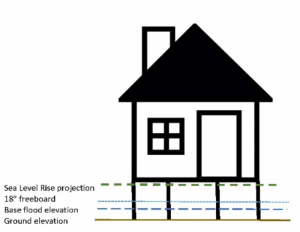Lewes properties within the 500-year flood plain may soon have a new set of standards to meet when redeveloping a home, or building or replacing critical infrastructure.
At its March 17 meeting, Lewes Planning Commission voted 7-2 to recommend that mayor and city council approve a proposed resiliency ordinance that determines how building within the flood plain should occur as sea levels rise. The city has chosen to use the intermediate line on the state’s most recent projections.
The current draft of the ordinance applies to construction of critical facilities and redevelopment of residential property located within the 100- and 500-year flood plains. New residential development will be addressed at a later time.
Residential redevelopment is defined as structures that are undergoing substantial improvement or have sustained substantial damage. The ordinance creates a formula to determine the required height for the first occupied floor. Currently, a home within the flood plain must be raised to the height of the base flood elevation, then an additional 18 inches, known as freeboard. If the proposed ordinance is adopted, a home must also be raised to meet sea-level rise projections 50 years in the future, based on the most recent data available.
Current models project sea-level rise of about 23 inches in 2071. Under the proposed formula, a home would be raised to the base flood elevation, plus 18 inches for freeboard, then an additional 23 inches for sea-level rise.
In terms of lot coverage, the ordinance mirrors what’s allowed in the the proposed source water protection ordinance, which is 50 percent maximum coverage with the option to increase to 60 percent with implementation of three runoff reduction practices. All residential property on Lewes Beach, except for a few marine-commercial parcels, is zoned R-3, which currently allows 65 percent lot coverage without any additional requirements. Based on the 500-year flood map, some R-2, low-density residential, and R-5, mixed residential, would be subject to the ordinance. R-5 properties already have lot coverage equal to the sea-level rise ordinance, while R-2 currently allows up to 65 percent lot coverage. Some commercially zoned property, which allows up to 95 percent lot coverage, appears to be close to the 500-year flood plain.
The critical facilities portion requires utilities to use the 40-year sea-level rise projection. It encourages new construction of critical facilities outside the flood plain; however, if such building or redevelopment occurs, the ordinance expects the facilities to be built to the 80-year sea-level rise projection.
Commissioners John Nehrbas and Joe Hoechner voted against the recommendation because they believe the maximum height of a building should rise with sea-level rise adjustments.
“We should change the height limit requirements if we’re telling people they need to build higher,” Nehrbas said.
Most residential buildings in Lewes are permitted to go up to 30.5 feet or 34 feet, depending on whether or not they are located in a flood zone. Most nonresidential buildings can be built to 40 feet.
Commissioner Tom Panetta said many homes being built to the existing height limit on Lewes Beach are meeting what would be required in the new ordinance.
“Our research shows most of the new buildings are being elevated for parking underneath, and they’re still able to maintain 34 feet,” he said. “With the parking underneath, [the first floor] is well above what the proposed elevation would be.”
Nehrbas and Hoechner’s objections were shared by many Lewes Beach residents among the public attendees at a March 11 hearing.
One such resident, Nick Carter, also suggested sea-level rise could slow down if the country puts more emphasis on alternative energy – electric vehicles, solar power, wind power, hydro power – as prescribed by the Biden administration. He also pointed to a recent vote by mayor and city council to ban certain gas-powered landscaping equipment by 2025.
Other residents think the proposed ordinance doesn’t go far enough.
“There have been studies that have come out recently that say we’ve passed the point where we are able to control it,” said Shipcarpenter Square resident Barbara Curtis. “I think we should be looking at the highest curve for predicting sea-level rise, and that might not even be enough.”
Mayor and city council will hold a public hearing on the proposed ordinance before scheduling a vote, which could happen as early as its May regular meeting.
Nick Roth is the news editor. He has been with the Cape Gazette since 2012, previously covering town beats in Milton and Lewes. In addition to serving on the editorial board and handling page layout, Nick is responsible for the weekly Delaware History in Photographs feature and enjoys writing stories about the Cape Region’s history. Prior to the Cape Gazette, Nick worked for the Delmarva Media Group, including the Delaware Wave, Delaware Coast Press and Salisbury Daily Times. He also contributed to The News Journal. Originally from Boyertown, Pa., Nick attended Shippensburg University in central Pennsylvania, graduating in 2007 with a bachelor’s degree in journalism. He’s won several MDDC awards during his career for both writing and photography. In his free time, he enjoys golfing, going to the beach with his family and cheering for Philadelphia sports teams.

























































